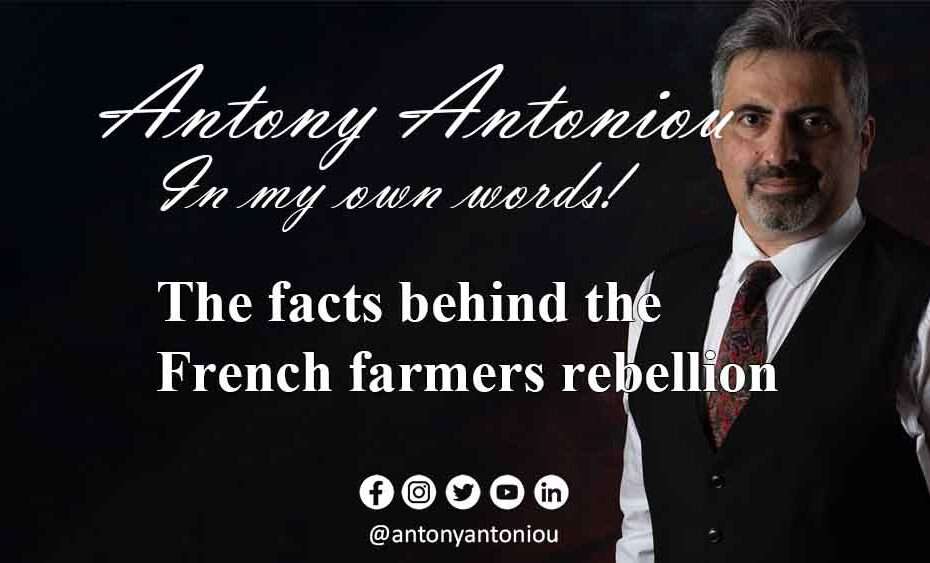The facts behind the French farmers rebellion
Farmers’ Rebellion: Unraveling the Fury Against EU Policies
Introduction
In recent times, the European agricultural landscape has witnessed a surge in protests as farmers express their anger towards EU policies and the green agenda. The catalyst for this discontent was a fiery but mostly peaceful protest that unfolded at the doorstep of the EU. This blog post delves into the reasons behind the farmers’ anger and the impact it’s having on European cities.
The Protest Unfolds
At the heart of the demonstration were over a thousand tractors, strategically blocking key routes in Belgium and France. Protesters, armed with banners proclaiming “No Farmers, No Food,” tore down a statue believed to be an EU founder. As a result, supermarket shelves in Belgium and France were left nearly empty, prompting a robust response from law enforcement.
French Fervor
The French, renowned for their fiery yet mostly peaceful protests, showcased their determination in this demonstration. Their tactics included encircling the capital with tractors to prevent foreign imports from reaching supermarkets. French police, in substantial numbers, were deployed to protect key locations, leading to the arrest of nearly a hundred farmers converging on a food distribution hub in Paris.
German Farmers Enter the Fray
Not to be outdone, German farmers adopted a more forceful approach, smashing through police cordons. But what exactly is fueling this widespread anger among European farmers?
The Core of the Anger
The root cause of this farmers’ rebellion lies in a multifaceted attack on their livelihoods by the EU. The measures include banning fertilizers, imposing emissions limits for climate change reasons, soaring energy prices, exorbitant tax hikes, and bureaucratic mandates forcing farmers to leave fields fallow. Additionally, an influx of cheap Ukrainian agricultural products, facilitated by the removal of quotas and tariffs, has inundated the European market.
Ukrainian Influence and Domestic Struggles
Ukraine’s dominance in wheat production has further crippled European farmers, as domestic producers find it challenging to compete under EU regulations. The farmers, in their own words, express the intensity of their frustration, highlighting the unfair competition and struggles imposed by EU policies.
EU Leaders’ Response
While farmers took to the streets, EU leaders seemed detached from their concerns. Simultaneously, a meeting resulted in the approval of an additional 50 billion euros in aid to Ukraine, exacerbating the farmers’ sense of neglect. French President Macron’s suggestion of granting the EU more power added insult to injury.
The Agenda Unveiled
The overarching agenda appears to be making farming unaffordable, bankrupting the industry, and displacing farmers from their lands. The consequences mirror a dystopian future reminiscent of China, where small farms succumb to corporate mega-farms, disrupting communities and contributing to a Net Zero climate change technocracy.
Backlash and Hope for Change
Despite the challenges, a continent-wide backlash against the technocrats is brewing, signaling potential change ahead of European parliamentary elections. The farmers, standing at the forefront of this resistance, are determined to protect their livelihoods and communities.
Conclusion
As Europe grapples with these unprecedented protests, the farmers’ rebellion remains a powerful reminder of the consequences of misguided policies. The clash between the agricultural sector and the EU illuminates the need for a balanced and sustainable approach to ensure the well-being of both farmers and the environment.
Summary
– **Widespread Discontent:** The farmers’ rebellion against EU policies reflects a widespread discontent within the agricultural community.
– **Multifaceted Attack:** EU measures, including fertilizer bans, emissions limits, and bureaucratic mandates, collectively contribute to the farmers’ struggles.
– **Unfair Competition:** Influx of cheap Ukrainian agricultural products, coupled with removal of quotas and tariffs, has left European farmers unable to compete on a level playing field.
– **Neglect from EU Leaders:** EU leaders’ detachment from farmers’ concerns, coupled with an allocation of additional aid to Ukraine, exacerbates the farmers’ sense of neglect.
– **Dystopian Future:** The overarching agenda seems to be making farming unaffordable, bankrupting the industry, and displacing farmers from their lands, reminiscent of China’s trajectory.
– **Continental Backlash:** Ahead of European parliamentary elections, a continent-wide backlash against technocrats is gaining momentum, with farmers at the forefront of this resistance.
– **Hope for Change:** The farmers’ rebellion serves as a potent reminder of the consequences of misguided policies, sparking hope for change and a reevaluation of EU agricultural strategies.
In conclusion, the clash between European farmers and the EU underscores the urgent need for a balanced and sustainable approach to safeguard the well-being of both farmers and the environment.

